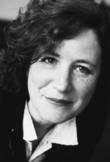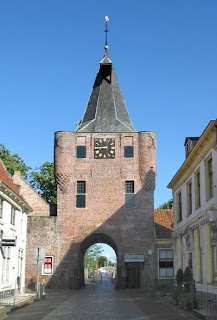Passion for a Passion, II, the sequel
This blog has led to bigger things!
Please visit our complete website at
www.wwclassicsonline.com
Micro country – Giga Tradition
Number two on society’s must be there list, it is astounding that year after year a long and complex work by Johann Sebastian Bach should immediately succeed the first catch of North Sea herring in importance in the Dutch collective conscious. Performances are sold out years in advance, you basically have to inherit tickets to get in, or alternatively, have been recently named to a cabinet post: the Passion in the Great Church of Naarden is where politics and society meet in multicultural and religiously tolerant (more or less), modern Holland...
This I blogged just a year ago, when Easter fell a whole month later and seasonal buds were inspiring, certainly as alternative to this year’s snow flakes-! Like clock work, we were in church yet again yesterday for this year’s performance of Bach’s Matthew Passion by the Netherlands Bach Society.
It is a bit of a circus of course, this passion for the Passion. On Good Friday and Easter Saturday, there is an intermission lengthy enough so that lunch can be served: comfortable and yet absurd of course, parallel to the intermission’s culinary delights at England’s Glyndebourne Festival.
This year the passion made front page headlines in reference to another performance taking place across the Atlantic:
Haitink finally conducts the Matthaüs
The Royal Concertgebouw Orchestra’s former Chief Conductor Bernard Haitink’s very first Matthew Passion was certainly front page newsworthy. Ironically, this iconic Dutch maestro, performed it very far from home, in one of his musically adopted cities, this time the venerable Boston. Here the Passion has also been a tradition, since 1871 to be exact, originally initiated by the Handel and Haydn Society of that very fair Euro-city, a stage where soprano Elly Ameling first brought a touch of the Dutch: her American nickname was instanteously angel. Haitink isn’t therefore the first export product in this oddly non-nationalist phenomenon from Holland, it was clearly very logical to contract Haitink in Boston however, where he is as beloved as the tradition itself. He casted the Passion well, even luxuriously. A veteran musical actor like Ian Bostridge was complimented by a new Dutch angel, Christiane Stotijn. Boston budgets are bulging these days, in painful contrast to many American orchestra’s, so Haitink could even live out his ambitions to cast the smaller, in his view ‘crucial’ roles, with top singers.
Haitink, on his maiden voyage with the Passion at a youthful 79, gave, according to those present, a marvellous performance, dramatic and deep. Yet the accompanying interview read, sadly perhaps, deeply frustrated. He cites never having been afforded the opportunity to perform the Passion at home in Holland, despite the tradition, or perhaps, actually due to it. ‘I never ask, I must be asked…’*.
Haitink heard his predecessor in Amsterdam Willem Mengelberg perform the Passion early, in 1939: Mengelberg was himself responsible for a sizeable chunk of the Dutch tradition. But by the time Haitink had morphed into a major maestro, the authentic performance practice was not only the avant garde of the 20th century in specialist circles, but had wormed its way into the conservative bulwarks of symphony orchestra’s.
The Dutchman Gustav Leonhardt and the Austrian Nicholas Harnoncourt produced the complete sacred cantates of JS Bach from their authentic point of view: thisproved to be an international bombshell of a success when it appeared between 1971 and 1990. The Concertgebouw Orchestra, in hindsight obviously not supported by its chief conductor, was visionary enough to contact Harnoncourt to conduct the Mathew Passion as early as 1978 to both critical and public enthusiasm. Harnoncourt has been returning to the orchestra to mutual satisfaction ever since. Haitink was alienated from a composer he clearly loved, Bach; Mozart would soon follow suit. His frustration, ‘an allergy’* at the ‘it has to be so, it cannot be otherwise’* authentic movement of the early, extremist years, placed Haitink in a no-win position, food for frustration.
In these schismatic years, when the music world once again investigated Bach (1685-1750) with utmost urgency, another conductor came to the fore, forced a less visible schism of his own, reinventing another Dutch tradition in the process: Jos van Veldhoven. Far less internationally famous than his colleagues Leonhardt and Harnoncourt, and certainly not in the same maestro stratosphere as Bernard Haitink, van Veldhoven has serenely and dedicatedly worked to take the authentic performance practice a few decided steps further, with Bach’s Mathew Passion has his major building block. As Artistic Director of the Netherlands Bach Society, van Veldhoven made a grand early decision to let others conduct the Passion every other year: rumor has it that he even contacted Bernard Haitink (maybe he never really ‘asked’) It was Van Veldhoven’s turn yet again yesterday; he led a performance which was special in many ways.
The Bach Society ensemble is always young, the instrumentalists and soloists are necessarily affordable (or decidedly dedicated); budgets here are a far cry from those known in Bostonian symphonic circles. The boys choir was a mere 6 in Naarden, the full choir (van Veldhoven refers to them as ‘ripenisten’ as opposed to the soloists) a mere 16. All were truly international: Holland still retains its Mecca status for students and young talent for renaissance and baroque music. Van Veldhoven has a talent for discovering tomorrow’s angels, and none was less angelic than the Swedish soprano Maria Keohane. Tenor Charles Daniels, a Bach Society veteran was never more dramatic than yesterday: heart wrenching. Two beautiful male altos were discoveries from England: Matthew White and William Towers. We were happily reunited with Gerd Turk as Evangelist and amazed for the first time at the power of Andrew Foster Williams as Christ.
The straight jacket of authenticity, which certainly served a purpose, putting this momentous repertoire back on both the performance and musicological agenda, has now clearly been put into perspective, giving way to urtext interpretations that go far deeper than merely the responsibly printed page. Amazing were van Veldhoven’s ritenuti at the ends of chorales and aria accompaniments for example, something that was a major no-no in the authenticity Bible not so long ago.
The Bach tradition has gone from fleshy, fat choirs and instrumental ensembles in the very early years, to immaciated, nearly anorexic thinness in the early, strictly authentic years ( a natural response perhaps). Now we can enjoy a voluptuousness recently still forbidden, a fineness of form, intelligent, warm and dramatic, elegant even. van Veldhoven was creative and convincing in his 2008 performance.
Holland has as yet been unsuccessful in adopting Johann Sebastian Bach despite its enviable number of appropriate organs and idem historic churches. It does claim a special relationship to this momentus work. Its rightful parents, the Germans, are certainly catching on, in fifth gear to convince and attract ever since Leipzig, true birth place of this Matthew Passion, became accessible after the fall of the Berlin wall. The Passion for this passion will surely continue in years to come. Perhaps as proof of its genius, performances are headline news, reassuring in these times when great classics are of marginal impact.
See for further information: www.bachvereniging.nl or www.bso.org
Or catch them of course, how fashionable, on YouTube. Better yet, get into a church, or second best, a concert hall, this time next year when the Passion week comes around: experience first hand what our passion is all about.
*As taken from an interview conducted by NRC Handelsblad music editor Kasper Jansen (March 22, 2008); the translation into English is my own.


No comments:
Post a Comment